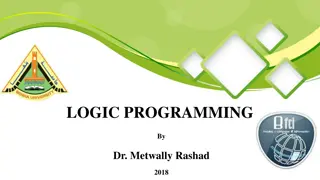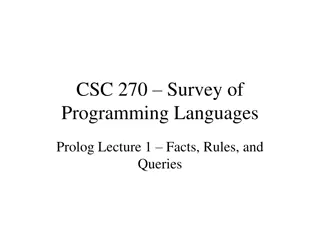Understanding Prolog: A Declarative Approach through the Years
Delve into the evolution of Prolog over the past 50 years, from its origins in natural language processing to its implementation and various features like tabling and negation. Explore the foundational concepts, syntax, and execution of Prolog, including its non-deterministic nature and recursive descent evaluation. Witness how Prolog functions as a relational language, emphasizing relations over functions, and learn about its SLD resolution strategy and the intriguing WAM architecture.
Download Presentation

Please find below an Image/Link to download the presentation.
The content on the website is provided AS IS for your information and personal use only. It may not be sold, licensed, or shared on other websites without obtaining consent from the author. Download presentation by click this link. If you encounter any issues during the download, it is possible that the publisher has removed the file from their server.
E N D
Presentation Transcript
50 Years of Prolog: Becoming More Declarative by David S. Warren Stony Brook University
Outline Intro - Background Prolog (original) Limitations Tabling (addresses incompleteness/performance) Negation Conclusion
Background Prolog invented by A. Colmerauer to process natural language (1972). Formalized by R. Kowalski as first-order Horn clause with SLD resolution as the inference (evaluation) strategy (1972). Is a relational language; it speaks of relations not functions, and thus is nondeterministic. Implemented by David H. D. Warren as DEC-10 Prolog (1973). Proposed a Prolog architecture, the WAM (1982) Many implementations over the years: C, BIM, Quintus, Sicstus, Eclipse, XSB, SWI, Ciao, YAP,
Prolog the Language, by example 1. Family Tree childOf(charles,elizabeth). childOf(william,charles). grandparent(C,GP) :- childOf(C,P), childOf(P,GP). childOf(harry,charles). childOf(george,william). childOf(charlotte,william). hasAncestor(C,A) :- childOf(C,A). childOf(louis,william). hasAncestor(C,A) :- childOf(C,P), hasAncestor(P,A). childOf(archie,harry). childOf(lilibet,harry). Queries: ?- childOf(archie,X). X=harry ?- grandparent(X,elizabeth). X=william ; X=harry ?- grandparent(X,Y). X=william,Y=elizabeth ; X=harry,Y=elizabeth ; X=george;Y=charles ; ?- hasAncestor(archie,A). A=harry ; A=charles ; A=elizabeth
What is Prolog; How does it work? Program statements are Horn clauses, i.e., implications with: Consequent is an atomic formula, and Antecedent is a conjunction of atomic formulas. Universally quantified Execution is SLD resolution with a depth-first backtracking search through the tree of resolution proofs. Uses unification to delay choice of variable values for as long as possible Procedurally is nondeterministic recursive descent evaluation of the clauses as procedure definitions
Prolog Evaluation Think of Prolog (nondeterministic) execution as a set of concurrently executing deterministic (procedural) machines. When a machine encounters a choice point with n alternatives: It replaces itself with n copies Each copy continues execution with one alternative When required variables don t match Machine fails and disappears Machines that return to initial procedure call provide answers.
Prolog Execution: Multiple Machines Machines Answer!
Another Example: Append Lists: e.g., [a,b,c,d] Constructor (or selector): [X|Y] represents the list with X as head and Y as tail Define append(L1,L2,L3) to be the 3-ary relation where the concatenation of lists L1 and L2 is L3: append([],L,L). append([X|L1],L2,[X|L3]) :- append(L1,L2,L3). Queries: ?- append([a,b,c],[d,e],L). L=[a,b,c,d,e] ?- append(L1,L2,[a,b,c]). L1=[],L2=[a,b,c] ; L1=[a],L2=[b,c] ; L1=[a,b],L2=[c] ; L1=[a,b,c].L2=[] ?- append([a,b,c],L2,L3). L3=[a,b,c|L2]
Why is Prolog Declarative? Relations are specified or defined by a set of implications Declarative statements of truth in a model SLD resolution provides the procedural strategy that determines how statements are proved true. Prolog programs can be understood declaratively. Prolog programs can be run in all directions; conceptually any equi- selection of the defined relation. It s wonderful! It s declarative! So, what s wrong?
Whats Wrong? Programs can be understood declaratively but they must be written with a firm eye on their procedural meanings: 1. Order of atoms in a rule body can be critical. Esp. for arithmetic. 2. Blind search of Prolog can be explosive. 3. Evaluation can loop infinitely, doing redundant computation. 4. Negative knowledge can be problematic. 5. How a problem is decomposed can greatly affect its solution efficiency. Problem: Declaratively correct programs are procedurally incorrect. Solution: More declarative Make more programs procedurally correct
More Declarativity Constraint processing addresses arithmetic and blind combinatorial search: Constraint Logic Programming over: Finite domains, Reals, Boolean, Program transformation addresses problem decomposition: Partial evaluation, fold-unfold transformations, RDB optimizations Open-ended: much more work to be done. Tabling addresses nontermination, performance, and negation issues: Will be the topic of the rest of this talk
Tabling: for Termination trans_close(X,Y) :- edge(X,Y). edge(a,b). trans_close(X,Y) :- trans_close(X,Z), edge(Z,Y). edge(b,c). edge(c,b). ?- trans_close(a,X). X=b ; X=c ; X=b ; X=c ; <infinite loop> Prolog evaluation loops. Prolog programmer: Of course it loops; it s left recursive Declarative programmer: Right recursion (see ancestor) loops, too. Why must either loop? Tabled evaluation terminates both (and many more)
Tabled Evaluation (not your father s memoization) Think of deterministic machines carrying out procedural evaluation Recall multiple deterministic machine model of Prolog execution. Prolog simulates these by depth-first, backtracking Tabled evaluation maintains global tables of calls and answers: When a machine calls a goal, it checks for a table: If call is in table, it suspends on the table and creates copy to return each answer as it shows up If not in the table, it adds it, suspends on the table, and starts machines for each clause When a machine returns an answer for a call, it adds it to the table, and fails Answers to query are those in table when computation ceases.
Tabled Eval of tc(a,Y)? :- table tc/2. 1 tc(X,Y) :- edge(X,Y). 2 tc(X,Y) :- tc(X,Z),edge(Z,Y). Y=b tc(a,Y) Y=c TABLES: b Add to table edge(a,b). edge(c,b). edge(b,c). tc(a,Y) tc(a,W) 1 W=b W=c b edge(a,Y) Add to table ?- tc(a,X). X=b ; X=c c tc(a,Y) 2 (^t) b c tc(a,Z) edge(b,Y) In table, ignore b (^t) c b edge(c,Y)
Tabled Evaluation of TC (description of previous animation) :- table tc/2. tc(X,Y) :- edge(X,Y). edge(a,b). tc(X,Y) :- tc(X,Z), edge(Z,Y). edge(b,c). edge(c,b). ?- tc(a,X). X=b ; X=c Initial call creates table [tc(a,?):] Calls edge, which returns b, to tc and it s added to table: [tc(a,?):b] LR call finds table, suspends, and duplicates self to continue with answer b It calls edge(b,Y), which returns c, returned to tc and added to the table: [tc(a,?):b,c] New answer, so suspended call duplicates self to continue with call to edge(c,Y) It returns Y=b, returned to tc, and b is already in the table, so it does nothing. Nothing more to do (all answers returned to all calls), so terminate.
Terminates for Datalog Terminates for all programs with only constants and variables (no data structures, e.g., lists) Datalog programs; Relational DB queries plus recursion Datalog includes context-free grammars, so recognizes all CF languages If grammar is in Chomsky form, it is Earley recognition DCG syntax for CFGs Complexity guarantees. E.g. O(n^k) where n is size of domain, n is max number of distinct variables in the antecedent of any rule
With Tabling Prolog is more Declarative More Prolog programs have meaningful computations All context-free grammars (and extensions) All Datalog programs All programs with the bounded term-size property But still must think about evaluation Easier for termination Consider only size of terms generated Easier for complexity Consider only number and size of tables, and duplicate answers
Negation in Prolog Prolog support negations of atomic formulas in antecedents. So-called negation-by-failure (aside: a misnomer) Not(Atom) succeeds if Atom (finitely) fails. Since tabling finitely fails more computations, it makes negation simpler, with a much cleaner semantics. Main semantic issue: What to do with cycles through negation? shaves(barber,Person) :- person(Person), not shaves(Person,Person). Who shaves the barber?
Who Shaves the Barber? Two (different) accepted semantics Well-founded 3-valued models (quadratic) Stable models (leading to Answer Set Programming) (NP-complete) Give different answers to the question WF: shaves(barber,barber) is given an undefined truth value (3-valued logic) For everyone other than the barber, the answer is as expected SM: No models, so program is inconsistent Don t know anything about anyone Tabling can be naturally and efficiently extended to compute truth in well-founded models
Conclusion Prolog is an evolving language Good evolution is toward increased declarativity Questions?
Meta-Programming Prolog 3-line self interpreter: interp(true). interp((A,B)) :- interp(A), interp(B). Interp(A) :- rule(A,Body), interp(Body). Tabling reflects right through: Making is easy to define (tabled) Prolog variations























